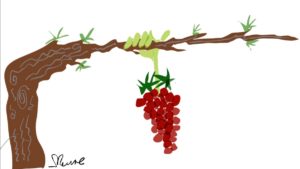
It’s a truism — perhaps by now a cliché — that wine is made in the vineyard. It’s a way of saying that winemakers who start with ripe, healthy fruit have most of the work done for them. The adage makes perfect sense when you consider that while grapes are still attached to a vine, they’re subject to every kind of natural adventure. Once they’re harvested and trundled off to the cellar and into the hands of a competent vintner, they’re safe from harm — or should be.
The cellar is where winemakers practice their craft and put their own spin on the ball; where decisions are taken on how long grapes will be allowed to macerate, how different lots will be blended, and whether the resulting wine will be matured in new oak, old oak, cement or stainless steel. It’s in the cellar where style happens. Or does it?
What’s missing from this picture is the degree to which human decision-making before harvest determines the character of the fruit that comes into the cellar — and the eventual shape of the wine itself. There’s lots that goes into this. Here, I’d like to focus solely on the mystery, complexity and ambiguity that lurk in that deceptively simple word: ripe. What is ripeness exactly, and how do we know when a wine grape has achieved it?
Anyone who has plucked an immature grape from a vine and eaten it knows how unpleasant the sensation can be. This is because grape berries start out with super high acid and very low sugar content. The process we call ripening progressively reverses this ratio until sugar levels are high enough to produce the required minimum alcohol level the prospective wine is subject to by law (it varies from region to region). If it were merely a question of getting the sugar content up to a certain level, a simple chemical analysis would do the trick. It’s more complicated than that — mainly to do with acidity and bitterness.
We’ve written here before about the critical contribution each of these common components make in shaping the character and drinkability of wine. To highlight their contributions, try performing the following thought experiment.
Imagine a glass of orange juice with just the right balance of fruit sugar and acid. Now, imagine that glass minus its acidity. It would be cloyingly sweet, lifeless and unappetizing. Lastly, imagine the same glass without any sweetness at all. Unmitigated by sugars, the sourness and bitterness would be overwhelming, setting your teeth on edge. Although it can be adjusted in the cellar, the acid/sugar balance in the fruit at harvest is strongly determinative of how the finished wine will present. But (sorry, Reader) there’s more.
It isn’t just sugars and acid in the juice of the grape that need to develop to a point of equilibrium. Because red wines are macerated on their skins (where tannins and pigments live) these too must have reached an acceptable level of maturity. Stems and seeds, when mature, turn brown and woody, rather than green and soft. It’s at this point that they lose the excessive bitterness they would otherwise impart.
In perfect growing seasons, grapes ripen slowly but steadily, at a pace that keeps everything in sync. In cool years, sugars struggle to develop. In hot years (more of these now than ever), they can race ahead of everything else, putting the winegrower in a challenging spot: Harvest now while there’s still some freshness in the fruit to keep it appetizing, risking introducing green, unripe flavors from not yet mature phenols (tannins; pigments); or let the fruit hang until everything else catches up, but with diminished levels of acidity that leave the finished wine flaccid and dull.
To hang in there, or not? It’s a judgment call — one that grapes cannot make for themselves and that frequently separates the seasoned and skilled winemaker from the merely competent — and fine wine from ordinary.